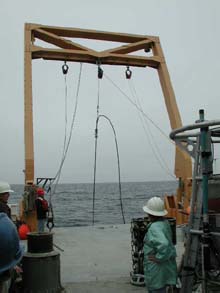
After 3 hrs of lifting, the cable finally surfaced. Here, the crew of the NOAA Ship Ronald H. Brown begins to secure the cable end so the science team can begin its work. Click image for larger view.
Installation of Hydrophone a Success!
September 2, 2001
Chris Fox, Director
Acoustic Monitoring Project
NOAA Pacific Marine Environmental Laboratory
![]() View a video of the installation. Requires QuickTime
View a video of the installation. Requires QuickTime ![]() .
.
After picking up passengers in San Francisco on August 30, the NOAA Ship Ronald H. Brown transited to Pioneer Seamount and the science team began operations the next morning. After performing some preliminary equipment tests, we acoustically located the cable recovery package on the sea floor and positioned the ship for recovery. The weather was nearly ideal, with relatively calm seas and light winds, but also morning fog that limited visibility. The recovery package was released, and 30 min later, the glass floats attached to the recovery line were spotted within 200 m of the ship.
The ship’s officers maneuvered the ship to bring the floats alongside, and the chief bosun grappled the recovery line and secured it to the fantail (the working deck at the rear of the ship). The ship was then positioned for recovery using the dynamic positioning navigation system, which allows the ship to remain stationary at a preselected location for extended periods. Once the ship was in position, the recovery of the cable end began, with nearly 1,500 m of recovery line hauled onto the ship until the cable end appeared. The connection of the recovery package to the cable had been accomplished in the summer of 2000 using a remotely operated vehicle.
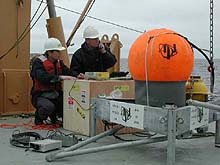
An engineering team from the University of Washington tested the cable prior to attaching it to the hydrophone array. Click image for larger view.
Electronic Testing and Reattachment
After 3 hrs of hauling, the cable end was recovered, and University of Washington (UW) engineers went to work to prepare the cable for testing and eventual attachment of the hydrophone array. The end was trimmed, cleaned, and configured for attachment, and testing began in late afternoon. Using the ship’s cellular telephone (fortunately, we were within range), the shipboard UW engineering team coordinated with UW and NOAA engineers at the shore end of the cable at Pillar Point Air Force Station on the California coast. Accurate measurement of the signal losses along the cable are critical to allow precise estimation of the level of acoustic noise received by the hydrophones. Signals of known frequency and amplitude were transmitted to shore, and their levels recorded.
The electronic testing required a total of about 6 hrs, which lasted into the evening. Then began redeployment of the cable, hydrophone array, and recovery package. This operation required using the ship’s winch to lower the hydrophone array into the water. Since the vertical hydrophone array will eventually extend to more than 100 m above the sea floor, it would be nearly impossible to deploy without its getting tangled in the winch wire. To accomplish the deployment, the hydrophone array was coiled in a large “bucket” with a foam float tied to the top by flexible cords. These cords were attached with metal links designed to corrode, and eventually dissolve, in sea water. The bucket was lowered to the sea floor with the array inside. Within a day or two, the link will dissolve and the float will rise above the base, pulling up the hydrophone array with it.
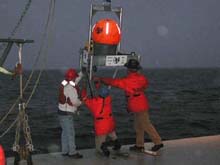
Once testing was complete, the science team attached the cable to the hydrophone array and slowly redeployed it on the submerged seamount. Click image for larger view.
Attached to the hydrophone array bucket with 200 m of nylon line was another plastic bucket containing a coiled recovery line with a float that can be acoustically commanded to release to the surface. This will allow us to return to the site in future years to recover the array and cable end to repair and/or attach new instruments to the cable. Finally, the recovery bucket was attached to the winch wire with another acoustic release that was used to finally lay the cable and attached instruments on the bottom. The ship relaid the cable by slowly moving forward while paying out wire. A sensor on the hydrophone package continuously reported the depth and tilt of the instrument to the engineers at Pillar Point. When informed by cellular telephone that the hydrophone array was stable on the bottom and in an upright position, and after allowing additional time to lay the 200 m of nylon line and the recovery bucket, the engineers sent the command to release the package to the sea floor, and the winch wire recovered.
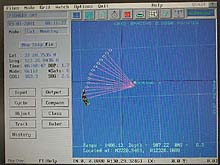
After the hydrophone was in place on the sea floor, a transponder was used to determine its exact location. Knowing the ship's location, the relative position of the hydrophone could be plotted. The ship's location is indicated by circles as it steams around the site of the deployed hydrophone. Click image for larger view.
Pinging
The final stage of the deployment required determining as accurately as possible the location of the hydrophone array on the sea floor. This is accomplished by extending an acoustic transmitter (or transducer) through a well in the ship’s hull and pinging (sending sound pulses) to a transponder on the hydrophone package. The transponder is designed to receive sound pulses at a given frequency and to return a sound pulse at a different preset frequency after a specified time delay. Knowing the ship’s position via Global Positioning System satellite navigation, as well as the "round-trip" travel time of numerous pings from numerous directions, the precise location of the package was determined to be 37 degrees 20.9655'N, 123 degrees 26.2375'W.
A late evening check with the team at Pillar Point indicated that the acoustic signals were being properly transmitted on the cable. NOAA engineers digitized the acoustic signals and transmitted the digital data to NOAA/PMEL’s Newport, OR laboratories via the commercial Internet. Marine mammal researcher Sharon Nieukirk reported the presence of blue whale calls even with the hydrophone still in the bucket! (Incidentally, no blue whales were seen during the deployment, but blue whale calls can propagated for hundreds of km.) The morning following deployment, the Pillar Point team reported a sudden (but slight) change in the tilt and depth of the hydrophone array bucket, which probably represented the release of the float and deployment of the array. The data transmitted to Newport are already being converted to spectrograms and will be available on the Web early next week.
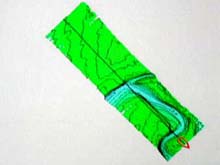
Most oceanographic cruises are quite active, with every moment dedicated to some element of research. This is a screen capture of data being collected on sea-floor depths. Click image for larger view.
En Route to San Diego
With the primary mission of the Sound in the Sea Expedition complete, the Ron Brown is now proceeding to San Diego for destaging and pickup of the next sea-going experiment. During the transit, whale observations were planned to document species around Pioneer Seamount, but no whales were spotted. Also during the transit, the ship's bathymetric mapping capabilities were used to improve sea- floor maps of offshore California. In particular, a detailed survey was conducted between Los Angeles and Santa Catalina Island to identify sites of partial and potential submarine landslides. The failure of unstable slopes in this region could present a tsunami threat to Los Angeles.
All in all, the Sound in the Sea expedition was a complete success, and made full use of the NOAA Ship Ronald H. Brown's extensive capabilities. Nevertheless, the exploration has only just begun. In the coming years, the undersea sounds recorded on the Pioneer Seamount hydrophone array will provide an unprecedented "look" at the dynamic processes constantly taking place in the ocean, and may, perhaps, reveal a few new mysteries of the deep.
Sign up for the Ocean Explorer E-mail Update List.









